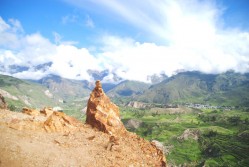
Much of the South American tourist trail twists and turns its way through the Andes, one of the highest mountain ranges in the world. It isn’t shocking, then, that altitude sickness is a problem travelers to South America frequently encounter.
Whether you’re hanging out in Cusco before heading to the Sacred Valley of the Incas or Machu Picchu or exploring the Bolivian capital of La Paz before you head southwest to the Uyuni Salt Flats, altitude sickness can strike you in many of the most popular South American tourist destinations.
Unfortunately, altitude sickness isn’t something you can predict based on your overall health or fitness. Even worse, it’s a sickness that comes on suddenly and whose symptoms may linger for days or even weeks. Although there is little you can do to fully rid yourself of altitude sickness if you experience it, there are steps you can take to lessen its impact on your travels through South America.

La Paz, Bolivia is one place you might come down with altitude sickness
Who Gets Altitude Sickness?
It would be tempting to think that altitude sickness only afflicts those who are out of shape or unhealthy. After all, people who’ve trained for a marathon are far more able to complete and even excel at the race than people who’ve never run a day in their lives.
Altitude sickness doesn’t really work like that, though. In order to imagine the effect altitude might have on your body, you have to consider how high some of these places are. Cusco, Peru, for example, is around 11,200 feet above sea level, while La Paz, Bolivia is in excess than 12,000, both more than twice the height of Denver.
Imagine, if you will, that the mountainous ground under your feet isn’t there and instead, that you are hovering 12,000 feet above the ground in flat-as-a-pancake New York City. Pretty dizzying, huh? Although your eyes can see that you are very much on the ground, your body isn’t always as aware. As a result, altitude sickness can affect literally anyone.

Altitude sickness may also come on in Cusco, Peru
Symptoms of Altitude Sickness
The first time I experienced altitude sickness was in a van at about 3 a.m., on the way from the city of Arequipa, Peru up over the Andes en route to the Colca Canyon.
My initial symptom was a nauseous, lightheaded feeling. I didn’t have time to think about how it was affecting me but rather, felt compelled to simply lay my head in my lap. Similar bouts of such symptoms would continue occurring throughout my time in the Andes, in Cusco, La Paz and everywhere in-between.
For some people, symptoms are more severe. Namely, you may actually vomit and rather than a fleeting lightheadedness, experience a headache or a full-on migraine. Nick, a Belgian I met at the Loki Hostel in Cusco, was literally bedridden for days. And trust me ladies, he was fit.

A fellow traveler in bed from altitude sickness in Cusco
Treatments for Altitude Sickness
The most terrible thing about altitude sickness, other than the fact that its onset and severity are completely unpredictable, is the lack of treatment options available. If your body doesn’t quickly adapt — which it well may; my symptoms became much milder as the weeks I spent in the mountains went on — your only option is to take it extremely easy, which may involve spending a lot of your trip at your hostel relaxing.
Another treatment option is chewing leaves of coca, the origin plant of cocaine. You can buy these leaves, which are legal to chew, almost anywhere in Peru or Bolivia. It’s also possible to drink coca as a tea, a less potent though more pleasant option. Coca tastes like crap!

Watch out for altitude sickness when you climb Machu Picchu
Are Coca Leaves Cocaine?
Although coca leaves are derived from the same plant as cocaine, coca leaves are not cocaine. The amount of stimulant in coca leaves is merely enough to power you through bouts of weakness that result from altitude sickness; you aren’t going to be high in the least.
But will coca leaves make you fail a drug test? I don’t know; I’m not a microbiologist. As I mentioned above, however, they are a common and accepted form of treatment for altitude sickness, something anyone who might refuse you a job due to a maybe-failed drug test can easily learn online.
I hope none of you reading this end up suffering from altitude sickness when you visit South America. If you do, however, get some coca, get some rest and pray that it passes.

Robert Schrader is a travel writer and photographer who’s been roaming the world independently since 2005, writing for publications such as “CNNGo” and “Shanghaiist” along the way. His blog, Leave Your Daily Hell, provides a mix of travel advice, destination guides and personal essays covering the more esoteric aspects of life as a traveler.








